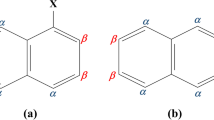Abstract
Ab initia SCF MO calculations employing a basis set of multi-component Gaussian orbitals are carried out for the FNO molecule at various internuclear angles and FN bond separations. The resulting total energy at the experimental FNO geometry is estimated to be in the range of 0.15 to 0.25 hartrees above the Hartree-Fock limit; the calculations find an internuclear equilibrium angle which is 1.1‡ higher than the experimental value (110‡) and a FN bond distance which is 0.02 bohrs greater than that found experimentally (2.872 bohrs). The molecular charge density contours indicate that nitrosyl fluoride can be considered quite concisely as a loosely bound combination of a fluorine atom and an NO radical. Finally, a model is constructed on the basis of the SCF calculations which is capable of explaining rather anamolous features of the FNO molecular geometry and properties in a consistent manner.
Zusammenfassung
Für das FNO-Molekül wurden bei verschiedenen Molekülwinkeln und FN-AbstÄnden ab initio SCF-MO-Berechnungen durchgeführt, wobei als Basis Atomfunktionen, welche sich jeweils aus einer grö\eren Anzahl von Gau\funktionen zusammensetzen, verwendet wurden. Dabei ergibt sich für das Molekül in der experimentellen Gleichgewichtsstruktur eine Gesamtenergie, welche als ungefÄhr 0,15 bis 0,25 Hartree über der Hartree-Fock Energie liegend abgeschÄtzt wird; die Berechnungen ergeben einen Wert für den Molekülwinkel, der 1,1‡ grö\er ist als der experimentelle (110‡) und eine um 0,02 Bohr grö\ere FN-BindungslÄnge als experimentell ermittelt worden ist (2,872 Bohr). Die berechnete Elektronendichteverteilung im Molekül deutet darauf hin, da\ FNO als Gebilde betrachtet werden kann, das aus einem Fluoratom und einem NO-Badikal besteht, welche nur locker aneinander gebunden sind. Auf Grund der SCF-Rechnungen wird weiterhin ein Modell entworfen, welches in der Lage ist, die Besonderheiten in der Struktur und den Eigenschaften des FNO-Moleküls auf konsequente Weise zu erklÄren.
Résumé
La molécule FNO est calculée par la méthode ab-initio SCF MO, utilisant une base d'orbitales gaussiennes multiples, pour différents angles et différentes distances FN. L'énergie totale obtenue pour la géométrie expérimentale est considérée comme se trouvant à 0,15-0,25 hartrees au dessus de la limite Hartree-Fock; les calculs fournissent un angle d'équilibre supérieur de 1,1‡ à la valeur expérimentale (110‡) et une distance F-N supérieure de 0,02 bohrs à la distance expérimentale (2,872 bohrs). Les contours de densité de charge montrent que le fluorure de nitrosyle peut Être considéré avec précision comme une combinaison entre un radical NO et un atome F faiblement lié. Sur la base des calculs SCF on construit un modèle capable d'expliquer raisonnablement des caractères anormaux de la géométrie et des propriétés de FNO.
Similar content being viewed by others
References
Magnuson, D. W.: J. chem. Physics 19, 1071 (1951).
Jones, E. A., and P. J. H. Woltz: J. chem. Physics 18, 1516 (1950).
Magnuson, D. W., E. A. Jones, and A. H. Nielson: J. chem. Physics 20, 378 (1952).
Pauling, L.: The nature of the chemical bond, 3rd ed., p. 345. Cornell University Press 1960.
Buenker, R. J., and S. D. Peyerimhoff: J. chem. Physics 45, 3682 (1966).
Peyerimhoff, S. D., and R. J. Buenker: J. chem. Physics 47, Sept. 15 (1967).
— —: J. chem. Physics 46, 1707 (1967).
Whitten, J. L.: J. chem. Physics 44, 359 (1966).
Buenker, R. J.: Ph. D. Thesis. Princeton University 1966.
Johnston, H. S., and H. J. Bertin: J. mol. Spectroscopy 3, 683 (1959).
Herzberg, G.: Spectra of Diatomic molecules, 2nd ed., p. 558. Princeton, N. J.: D. van Nostrand Co., Inc. 1961.
Cade, P. E., K. D. Sales, and A. C. Wahl: J. chem. Physics 44, 1973 (1966).
Huo, W.: J. chem. Physics 43, 624 (1985).
Peyerimhoff, S. D.: J. chem. Physics 47, 349 (1967).
Tables of Interatomic Distances and Configurations in Molecules. The Chemical Society, London, spec. publication no. 11, 1958 and no. 18, 1965.
Cook, R. L.: J. chem. Physics 42, 2927 (1965).
Schomaker, V., and C.-S. Lu: J. chem. Soc. (London) 72, 1182 (1950).
Watson, H. E., G. P. Kane, and K. L. Ramaswamy: Proc. Roy. Soc. (London) A156, 130 (1936).
Ref. [4], p. 344.
Author information
Authors and Affiliations
Rights and permissions
About this article
Cite this article
Peyerimhoff, S.D., Buenker, R.J. Ab initio study of the molecular geometry and properties of nitrosyl fluoride. Theoret. Chim. Acta 9, 103–115 (1967). https://doi.org/10.1007/BF00529944
Received:
Issue Date:
DOI: https://doi.org/10.1007/BF00529944




